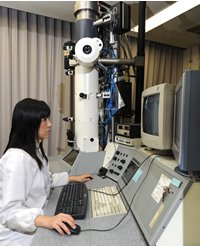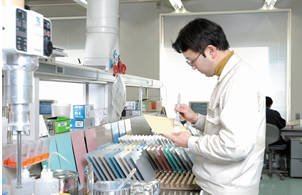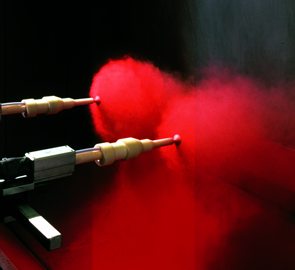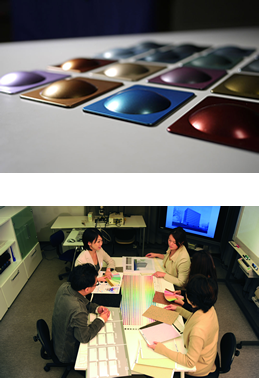
Research & Development Stages
Basic Technology

Kansai Paint has its R&D facilities and organizations located collectively in its R&D Center at Hiratsuka, Japan. Basic technological research is also centralized at the same premises together with both dedicated technical experts and advanced laboratory equipment.
The key to providing paint with various functions lies in synthetic polymers. Functions of paint such as low dirt-smearing or water-repellence are obtained by polymer designs and syntheses at molecular level. These kinds of synthetic polymers are so diverse that technical staff at Kansai Paint research the best options from among innumerable combinations.
The advances in computer science of recent years have also been applied to this field in order to help simulate chemical reactions and the molecular structures of paint components. As a result of these steady efforts, the product research and development time has been vastly reduced.
Kansai Paint also utilizes the latest in analytical and physical measuring equipment in order to identify the behavior of various paint components and to improve the physical and chemical properties of the paint film. As an example, the data obtained on the rheology of wet or dry film helps to provide a solid foundation and back-up to the research and development tasks carried out.
Paint Technology

Kansai Paint is a comprehensive manufacturer of paints and coatings. We develop and supply the most advanced products to almost all of the industrial sectors. All-round performance is the main requirement of paint and no matter how revolutionary the material or technology may be; it will never be commercially produced if there is even a single problem in the paint’s quality or if it is too costly to produce. Moreover, even if the paint has an excellent quality, if it cannot be practically applied to build a sound film it will also be discarded.
Over the past few years it has become even more important to develop environmentally friendly and people-friendly products. Therefore, it is a prerequisite for the R&D team to ensure that hazardous substances are not used and to pay full attention to the reduction of VOC (volatile organic compounds) during the process of application and curing of the paint.
The key to solving these problems, meeting each and every requirement, and launching innovative and attractive products is in scientifically controlling the composition of multiple substances, the individual behavior of each component and the chemical interactions among them within the paint. One may say that paint technology is indeed a fine art form of chemistry itself. Currently a large number of these highly advanced technologies are exported by Kansai Paint on a technical license around the world.
Application Technology

Paint in a can is not an end user product yet. Paint only becomes a valuable material and plays its role when it is applied to the surface of an object through a specific application process. Application methods play a big part in determining the final appearance of the dry paint film and the quality that the paint gives the finished product. On top of this it often affects paint film performance too. Therefore, it is also of great importance for both the economy and the environment to minimize the overspray of paint which falls off the substrate or becomes airborne without attaching to the surface of an object during application. By avoiding excessive overspray through special application processes the amount of resources used as well as the overall cost can be greatly reduced.
As a paint manufacturer, Kansai Paint researches these application technologies in order to achieve a high level of customer satisfaction by providing services and an integrated system of paint and application processes. For example, the R&D team of Kansai Paint’s Automotive OEM Coatings division has introduced a full-size application line in its laboratory at Hiratsuka which is identical to one used at a car manufacturer’s plant. This allows the R&D teams to gather the necessary data to pursue, in a practical manner close to the car manufacturer’s line conditions, further development in both the paint and paint application fields.
Color Technology & Color Design

Paint has two goals that it needs to fulfill; one is to protect the coated object and the other is to give added value to the product provided by the paint’s aesthetically pleasing color properties, which can affect human psychology. This is especially relevant as in the modern world a strong emphasis is placed upon “sensitivity”, and the consumer expectation for high quality paint is getting stronger and stronger in many societies across the world.
However, beauty alone does not make the paint. Paint must be beautiful on the one hand and on the other its desired functions must perform well under harsh conditions for a long period of time. In many cases, despite the paint’s desirable color, it cannot be produced commercially due to its poor performance and poor durability in practical usage. In the color research and design laboratories at Kansai Paint, designers and chemists work together in an attempt to improve both the functional and aesthetic aspects of the paint.
Moreover, to create a pleasant living and working environment, Kansai Paint creates positive color designs such as “stress-free office colors”, and “elderly-friendly colors”. These efforts have been recognized by various organizations with reputable awards and as such we are confident that our product can deliver. The world of “color” tends to be perceived only by sensitivity or sentiment, but in actuality it is backed by sound logic and reasoning.




